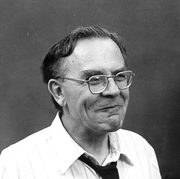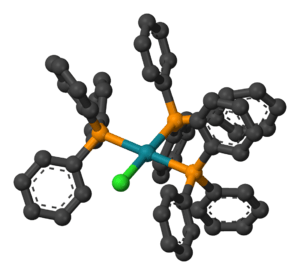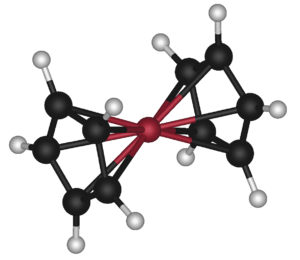Geoffrey Wilkinson facts for kids
Quick facts for kids
Sir Geoffrey Wilkinson
|
|
|---|---|
 |
|
| Born | 14 July 1921 Todmorden, West Riding of Yorkshire, England
|
| Died | 26 September 1996 (aged 75) London, England
|
| Nationality | British |
| Alma mater | Imperial College London (PhD) |
| Known for | Homogeneous transition metal catalysis |
| Awards |
|
| Scientific career | |
| Fields | Inorganic chemistry |
| Institutions | |
| Thesis | Some physico-chemical observations on hydrolysis in the homogeneous vapour phase (1946) |
| Doctoral advisor | Henry Vincent Aird Briscoe |
| Other academic advisors | Glenn T. Seaborg (post doctoral advisor) |
| Doctoral students |
|
| Influenced | Malcolm H. Chisholm |
Sir Geoffrey Wilkinson (born July 14, 1921 – died September 26, 1996) was a famous English chemist. He won the Nobel Prize in Chemistry for his important work. He was a pioneer in inorganic chemistry, which is the study of chemicals that don't contain carbon. He also worked on how to speed up chemical reactions using transition metals.
Contents
Early Life and Schooling
Geoffrey Wilkinson was born in Todmorden, England. His father was a painter, and his mother worked in a cotton mill. His uncle, who was a choirmaster, owned a small chemical company. This company made special salts for medicines. This is where young Geoffrey first became interested in chemistry.
He went to the local primary school. In 1932, he won a scholarship to attend Todmorden Grammar School. His physics teacher there, Luke Sutcliffe, had also taught another Nobel Prize winner, Sir John Cockcroft. In 1939, Geoffrey earned another scholarship to study at Imperial College London. He finished his first degree in 1941 and earned his PhD in 1946.
Career and Discoveries
In 1942, Geoffrey Wilkinson joined a project about nuclear energy. He moved to Canada and worked there until 1946. After that, he worked with Professor Glenn Seaborg at the University of California, Berkeley. There, he mostly studied different types of atomic elements.
He then became a researcher at the Massachusetts Institute of Technology. He started to focus on his main interest: how transition metals combine with other chemicals. These combinations are called "complexes."
From 1951 to 1955, he worked at Harvard University. Even though he did some nuclear research there, he also started working on complexes involving chemicals called olefins.
In 1955, he became a professor at Imperial College London. From then on, he focused almost entirely on the complexes of transition metals.
Sir Geoffrey Wilkinson is famous for two big discoveries. One is the structure of a chemical called ferrocene. The other is a special chemical called Wilkinson's catalyst. This catalyst helps to add hydrogen to other chemicals, turning alkenes into alkanes. This process is used in industry to make many different products.
He also taught and guided many students who went on to become important chemists themselves.
Awards and Recognition
Geoffrey Wilkinson received many awards for his amazing work. In 1973, he won the Nobel Prize in Chemistry. He shared this prize with Ernst Otto Fischer for their work on "organometallic compounds." These are special chemicals that contain a bond between a metal and carbon.
He also wrote a very important textbook called "Advanced Inorganic Chemistry." Many students and scientists still use this book today. It is often simply called "Cotton and Wilkinson."
In 1965, he became a Fellow of the Royal Society (FRS). This is a very high honor for scientists in the UK. In 2009, a new student residence hall at Imperial College London was named "Wilkinson Hall" in his honor.
Personal Life
Sir Geoffrey Wilkinson was married to Lise. They had two daughters named Anne and Pernille.
See also
 In Spanish: Geoffrey Wilkinson para niños
In Spanish: Geoffrey Wilkinson para niños



